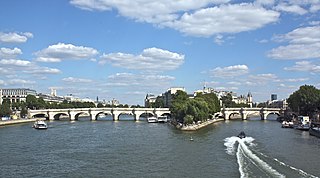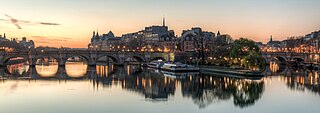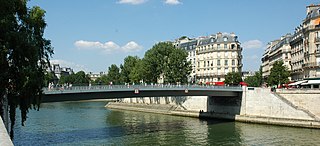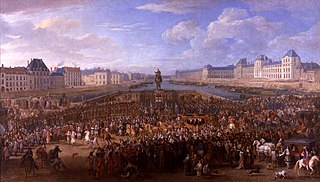
The Pont Neuf is the oldest standing bridge across the river Seine in Paris, France. It stands by the western (downstream) point of the Île de la Cité, the island in the middle of the river that was, between 250 and 225 BCE, the birthplace of Paris, then known as Lutetia and, during the medieval period, the heart of the city.

Île de la Cité, 22.5 hectares in size, is one of two natural islands in the Seine, in central Paris. In the 4th century, it was the site of the fortress of the area governor for the Roman Empire. In 508, Clovis I, the first King of the Franks, established his palace on the island. In the 12th century, it became an important religious center, the home of Notre-Dame cathedral, and the royal chapel of Sainte-Chapelle, as well as the city hospital, the Hôtel-Dieu. It is also the site of the city's oldest surviving bridge, the Pont Neuf.

Pont Marie is a station of the Paris Métro opened in 1926 with the extension of Line 7 from Palais Royal–Musée du Louvre. It is named after the nearby bridge over the Seine, the Pont Marie, which connects to Île Saint-Louis.

Île Saint-Louis, eleven hectares in size, is one of two natural islands in the Seine river, in Paris, France. Île Saint-Louis is connected to the rest of Paris by four bridges to both banks of the river and to the Île de la Cité by the Pont Saint-Louis.

The Pont Saint-Bénézet, also known as the Pont d'Avignon, was a medieval bridge across the Rhône in the town of Avignon, in southern France. Only four arches survive.

The Pont des Arts or Passerelle des Arts is a pedestrian bridge in Paris which crosses the River Seine. It links the Institut de France and the central square of the Palais du Louvre,.

The Pont de Bir-Hakeim, formerly the Pont de Passy, is an arch bridge that crosses the Seine in Paris. It connects the 15th and 16th arrondissement, passing through the Île aux Cygnes. The bridge, made of steel, was constructed between 1903 and 1905, in replacement of a footbridge that had been erected in 1878. The bridge has two levels: one for motor vehicles and pedestrians, the other being a viaduct built above the first one, through which passes Line 6 of the Paris Métro. The bridge is 237 metres (777 ft) long and 24.7 metres (81 ft) wide. The part crossing the Grand Bras of the Seine is slightly longer than the one crossing the Petit Bras.

The Pont de Sully is a bridge across the Seine in Paris, France.

The Pont de la Tournelle, is an arch bridge spanning the river Seine in Paris.

The Pont Royal is a bridge crossing the river Seine in Paris. It is the third oldest bridge in Paris, after the Pont Neuf and the Pont Marie.
The Pont Notre-Dame is a bridge that crosses the Seine in Paris, France linking the quai de Gesvres on the Rive Droite with the quai de la Corse on the Île de la Cité. The bridge is noted for being the "most ancient" in Paris, in the sense that, while the oldest bridge in Paris that is in its original state is undoubtedly the Pont Neuf, a bridge in some form has existed at the site of the Pont Notre-Dame since antiquity; nonetheless, it has been destroyed and reconstructed numerous times, a fact referred to in the Latin inscription on it to honor its Italian architect, Fra Giovanni Giocondo. The bridge once was lined with approximately sixty houses, the weight of which caused a collapse in 1499.

The Petit Pont is an arch bridge crossing the River Seine in Paris, built in 1853, although a structure has crossed the river at this point since antiquity. The present bridge is a single stone arch linking the 4th arrondissement and the Île de la Cité, with the 5th arrondissement, between quai de Montebello and quai Saint-Michel. The Petit Pont is notable for having been destroyed at least thirteen times since its original inception during Gallo-Roman times to the mid-19th century.

Pont Saint-Michel is a bridge linking the Place Saint-Michel on the left bank of the river Seine to the Île de la Cité. It was named after the nearby chapel of Saint-Michel. It is near Sainte Chapelle and the Palais de Justice. The present 62-metre-long bridge dates to 1857.

The Pont Louis-Philippe is a bridge across the River Seine in Paris. It is located in the 4th arrondissement, and it links the Quai de Bourbon on the Île Saint-Louis with the Saint-Gervais neighborhood on the right bank.

The pont Saint-Louis is a pedestrian bridge across the River Seine in the 4th arrondissement of Paris. It links the Île de la Cité with the Île Saint-Louis. It is served by the Cité stop of the Paris Metro.

The Pont de Neuilly is a road and rail bridge carrying the Route nationale 13 (N13) and Paris Métro Line 1 which crosses the Seine between the right bank of Neuilly-sur-Seine and Courbevoie and Puteaux on the left bank in the department of Hauts-de-Seine. It faces the headquarters of La Défense and is aligned on the Axe historique of Paris.

Paris in the 17th century was the largest city in Europe, with a population of half a million, matched in size only by London. It was ruled in turn by three monarchs; Henry IV, Louis XIII, and Louis XIV, and saw the building of some of the city's most famous parks and monuments, including the Pont Neuf, the Palais Royal, the newly joined Louvre and Tuileries Palace, the Place des Vosges, and the Luxembourg Garden. It was also a flourishing center of French science and the arts; it saw the founding of the Paris Observatory, the French Academy of Sciences and the first botanical garden in Paris, which also became the first park in Paris open to the public. The first permanent theater opened, the Comédie-Française was founded, and the first French opera and French ballets had their premieres. Paris became the home of the new Royal Academy of Painting and Sculpture, and of some of France's most famous writers, including Pierre Corneille, Jean Racine, La Fontaine and Moliere. Urban innovations for the city included the first street lighting, the first public transport, the first building code, and the first new aqueduct since Roman times.
Christophe Gamard, Gamar or Gamart, was a 17th-century French architect, who worked in Paris and died there in 1649.


















